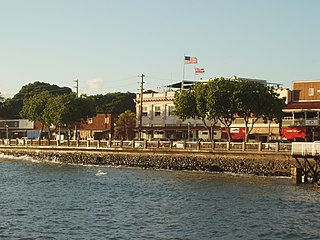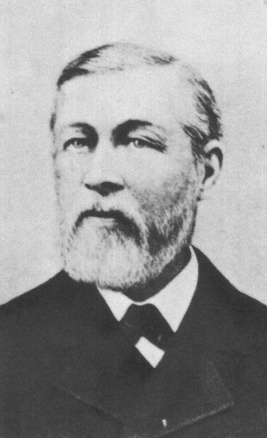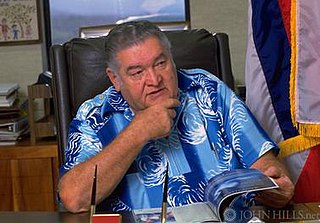
Lahaina is a census-designated place (CDP) in Maui County, Hawaii, United States. On the northwest coast of the island of Maui, it encompasses Lahaina town and the Kaanapali and Kapalua beach resorts. As of the 2020 census, Lahaina had a resident population of 12,702. The CDP spans the coast along Hawaii Route 30 from a tunnel at the south end, through Olowalu, and to the CDPs of Kaanapali and Napili-Honokowai to the north.

James Campbell, Esq. was a Scots-Irish industrialist in sugar cane processing, who became one of the largest landowners in the United States Territory of Hawaiʻi, and a real estate developer. He was an immigrant to Hawaiʻi from Ireland. At the age of 51, he married for a second time, to a young woman who was a daughter of Hawaiian aristocracy. They had eight children, four of whom survived to adulthood. One of their daughters married into the ruling family, and their grandchildren were heirs to the throne of the kingdom of Hawaii.

Kīpahulu is an unincorporated community in the Hāna district of southeastern Maui, Hawaiʻi.

Puʻunēnē is an unincorporated community in the central part of Maui, Hawaii, United States, with a population of just around 50. Although the land is fairly level, the Hawaiian name for the area means "goose hill", in reference to the endemic nēnē.
Hawaii Superferry was a Hawaii-based transportation company that provided passenger and vehicle transportation between Honolulu Harbor on the island of Oʻahu and Kahului Harbor on Maui. Legal issues over environmental impact statements and protests from residents of Maui and Kauaʻi temporarily delayed the implementation of service, but service between Oʻahu and Maui began in December 2007. The company had hoped to return service to Nawiliwili Harbor on Kauaʻi and additionally planned to eventually provide service to Kawaihae Harbor on the Big Island.
Maui Land & Pineapple Company, Inc. is a land holding and operating company founded in 1909 and based in Kapalua, Hawaii, United States. It owns approximately 24,300 acres (100 km2) on the island of Maui. It develops, sells, and manages residential, resort, commercial and industrial real estate; and operates retail, golf and utility operations at the Kapalua Resort. ML&P also owns and manages the 8,304-acre (33.61 km2) Puʻu Kukui Watershed Preserve, one of the largest private nature preserves in the state of Hawaii. It formerly grew pineapples.
At their peak, there were six Chinese Society Halls on Maui. Operated by the Gee Kung Tong Society, these halls were created to provide services to immigrant Chinese workers, mostly working for the sugarcane plantations. All provided religious and political help, in addition to mutual aid. Only the Wo Hing Society Hall in Lahaina and the Ket Hing Society Hall in Kula have survived. Both were placed on the Hawaii State Register of Historic Places on July 30, 1982, and placed on the National Register of Historic Places on November 15, 1982. The Chee Kung Tong Society Hall was placed onto both State and Federal registers, but collapsed in 1996.

Lahaina Historic District is a National Historic Landmark District encompassing most of the community of Lahaina, Hawaii, on the west side of the island of Maui in the US state of Hawaii. Designated in 1962, the district recognizes Lahaina for its well-preserved character as a 19th-century port, and for its social and economic importance in the 19th century as a major whaling center in the Pacific, and as one of the capital cities of the Kingdom of Hawaii.

Mokuʻula was a tiny island that has been buried beneath a baseball field in Maluʻulu o Lele Park, Lahaina, Hawaiʻi, United States. It was the private residence of King Kamehameha III from 1837 to 1845 and the burial site of several Hawaiian royals. The 1-acre (4,000 m2) island is considered sacred to many Hawaiians as a piko, or symbolic center of energy and power. It was added to the Hawaiʻi State Register of Historic Places on August 29, 1994, and to the National Register of Historic Places on May 9, 1997, as King Kamehameha III's Royal Residential Complex.

The island of Maui with a relatively central location has given it a pivotal role in the history of the Hawaiian Islands.

Kapalua Resort is a golf and beach resort in Kapalua, Hawaii on the northwest shore of the island of Maui near Lahaina, Hawaii. It is owned by Maui Land & Pineapple Company.

Lāhainā Noon is a semi-annual tropical solar phenomenon when the Sun culminates at the zenith at solar noon, passing directly overhead. The term "lāhainā noon" was coined by the Bishop Museum in Hawaiʻi.

Dwight Baldwin was an American Christian missionary and medical doctor on Maui, one of the Hawaiian Islands, during the Kingdom of Hawaii. He was patriarch of a family that founded some of the largest businesses in the islands.

Maui Bus is the public transportation service of the island of Maui, Hawaii, and is operated by Roberts Hawaii under a public-private partnership with Maui County government. They operate 13 regular local bus routes and 4 commuter routes, which have a single early morning run and a return trip in the afternoon and require a reservation.
Charmaine Tavares is an American politician and teacher. Tavares served as the Mayor of Maui from January 2007 to January 2011. She unsuccessfully sought a second four-year term in office in the 2010 Maui mayoral election.

Hannibal M. Tavares was an American politician who served as the 2nd Mayor of Maui from October 1979 until January 2, 1991. He was the longest-serving mayor of Maui.

Lahaina Banyan Court Park is a public park located at the corner of Front Street and Canal Street in the town of Lahaina, Hawaii, which was the capital of the Kingdom of Hawaii from 1820 to 1845. The 1.94 acres (0.79 ha) park, also known as Lahaina Courthouse Square and commonly called Banyan Tree Park, contains multiple heritage sites on the Lahaina Historic Trail, and a self-guided walking tour through the Lahaina Historic Districts.
Captain James Makee was one of the pioneer planters of Hawaii and the owner of the most productive sugar plantations on Maui.

Carthaginian was a three-masted barque outfitted as a whaler that served both as a movie prop and a museum ship in Hawaii. Laid down and launched in Denmark in 1921 as the three-masted schooner Wandia, she was converted in 1964–1965 into a typical square-rigged 19th-century whaler for the filming of the 1966 movie Hawaii. Afterward, she was moored in the harbor of the former whaling port-of-call of Lahaina on the Hawaiian island of Maui, explaining the whaling industry in the Hawaiian islands. Carthaginian was lost in 1972 when she ran aground just outside the harbor on its way to drydock maintenance on Oahu and was replaced as a whaling museum by Carthaginian II in 1980.
Emma Maynon Kaipuala Veary is a lyric Coloratura soprano born in Hawaii.
















